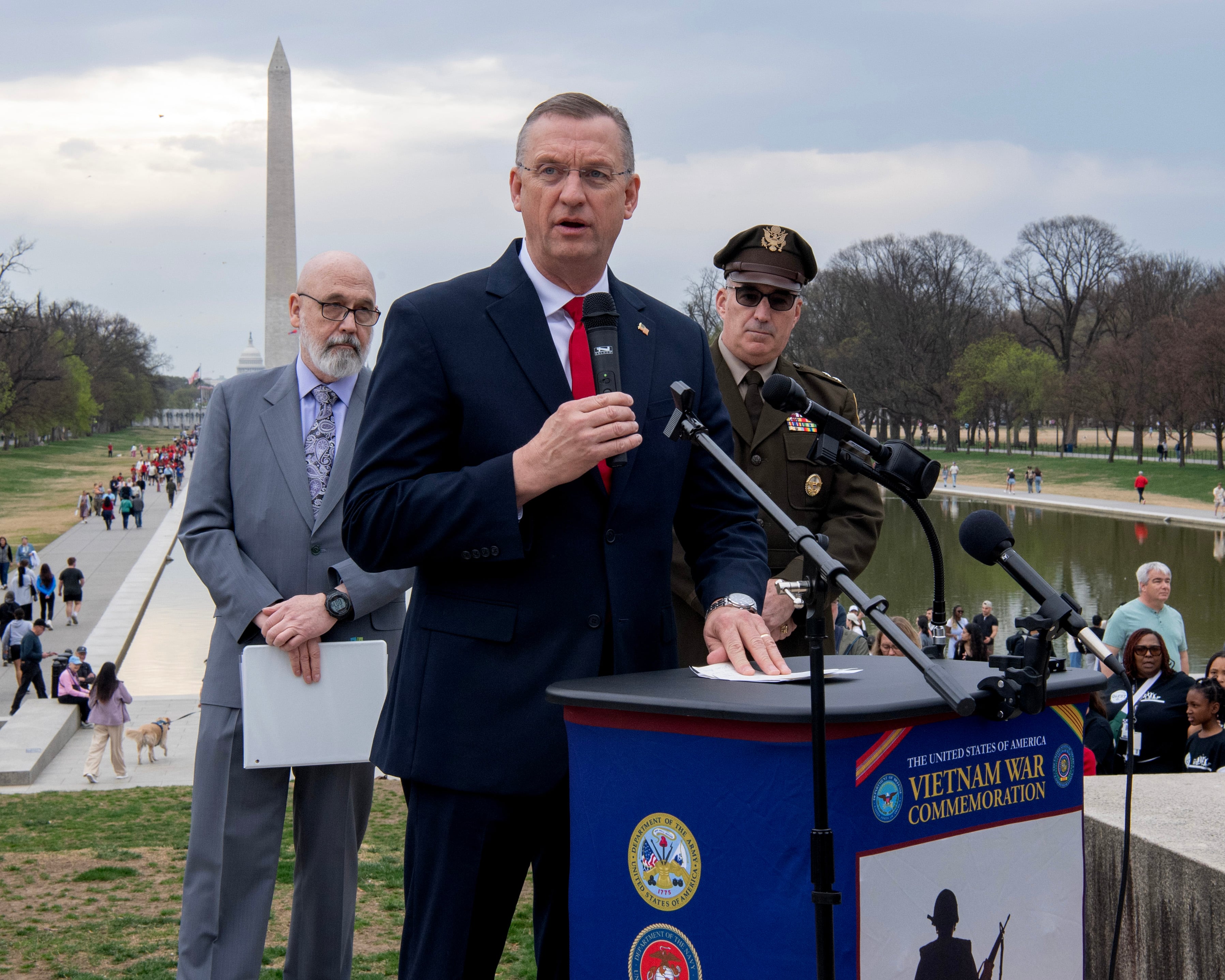As her tenure as Air Force secretary comes to an end, experts say Barbara Barrett, who kept a lower profile than her predecessors, will be remembered for several important accomplishments, including the quiet, steady stand-up of the Space Force.
In interviews with Air Force Times, Hawk Carlisle, president of the National Defense Industrial Association, and defense policy expert John Venable of the Heritage Foundation said that splitting part of the Air Force into the military’s sixth service could have gone awry in many ways.
But, they said, the Department of the Air Force made it happen without significant public ruptures, which they credited to Barrett’s behind-the-scenes leadership.
“When you throw a wrench in the works with a significant organizational change like this one, it causes folks to rise up and fight it,” Venable, a former Air Force fighter pilot, said in an interview Wednesday. “You didn’t catch wind of that. I never read an article that said, ‘The Air Force is tearing itself apart in this birthing process of the Space Force.’”
The Air Force held a socially distanced farewell ceremony Thursday for Barrett, as well as other top officials such as acquisition chief Will Roper and assistant secretary for manpower and reserve affairs Shon Manasco, at Joint Base Anacostia-Bolling in Washington DC.
“We are a better Air Force because of Secretary Barrett’s passion, commitment, leadership and heart,” Chief of Staff Gen. Charles “CQ” Brown said at the ceremony.
Brown said he saw during their trips how deeply Barrett cared for airmen and their families. He also lauded Barrett for her leadership during the turmoil of 2020, including the coronavirus pandemic and the racial unrest that followed the death of George Floyd.
“When our nation faced the greatest pandemic it’s seen in 100 years, the department didn’t slow down, it accelerated,” Brown said. “When George Floyd was murdered, and our airmen were hurting and wanted a voice, you gave it to them. You led the Department of Defense’s work on diversity and inclusion, to ensure meaningful, measurable and sustainable improvements became an enduring part of our military.”
RELATED

In her remarks, Barrett praised the airmen she helped lead, and said she leaves confident the nation is safe because of them.
“There is one eye-watering constant across the Air and Space Forces: the universality that these are good people,” she said. “I have worked at numerous businesses, I have been a member of dozens of groups, and I have been part of myriad organizations, but I have never been part of any entity where there is such consistency of good intent and effort to be the best, together.”

Barrett, who became the Air Force’s 25th secretary in October 2019, will leave next week, shortly before President-elect Joe Biden is inaugurated. Biden has not yet announced his pick for Air Force secretary.
Carlisle and Venable said that Barrett kept a relatively low profile in the Pentagon, but guided several moves that will have long-lasting effects on the Air Force.
When Barrett came in as secretary, Carlisle said, the hunt was already under way for the Air Force’s next chief of staff, and Brown, then commander of Pacific Air Forces, was at or near the top of the list. Barrett helped ensure his historic nomination by President Trump and confirmation as the service’s 22nd chief of staff, as well as the first-ever Black officer to head any military service, he said.
Barrett’s shepherding of Brown, a highly respected officer whose selection was widely praised, through the nomination process and into the Air Force’s top uniformed position ensures the service is left with a steady and skilled leader for years to come, Carlisle said.
When the time came to create the Space Force, Carlisle said, one of Barrett’s most significant contributions was to ensure it was on an equal footing with the Air Force from which it was created.
By not allowing it to become a junior service within the Department of the Air Force, the Space Force and Chief of Space Operations Gen. Jay Raymond now have an equal voice when it comes to making decisions, Carlisle said. This, he said, gives the Space Force comparable stature to that enjoyed by the Marine Corps within the Department of the Navy.
Creating the Space Force wasn’t easy, Carlisle said. Not all of the Air Force was on board with the idea of creating a separate service, he said. But Barrett got it done in exceptionally rapid time, especially when compared to the seven years it took to create U.S. Special Operations Command after the catastrophic 1980 mission to rescue U.S. hostages in Iran.
“She clearly had her finger on the pulse, at all the levels, to make sure there wasn’t that undercurrent of disagreement,” Carlisle said.
In an administration where senior leaders often ran the risk of provoking the ire of President Trump — sometimes quite publicly — Barrett seems to have always stayed on his good side, Carlisle said. That was no mean feat, particularly since Trump made creating the Space Force one of his signature projects.
Under her watch, the Air Force recently chose the Army’s Redstone Arsenal in Huntsville, Alabama, as the new headquarters of U.S. Space Command. That decision is already proving controversial, though, as lawmakers in Colorado — which also was vying for Space Command’s headquarters — are alleging Alabama was chosen for political reasons and calling on the incoming Biden administration to reconsider.
That will also be part of Barrett’s legacy, Carlisle said, and it remains to be seen how the Space Command controversy will end up.
Venable lauded Barrett’s Air Force for enacting some of the biggest changes to the officer personnel system in a generation by getting rid of below-the-zone promotions and breaking the larger Line of the Air Force group into smaller, better-defined competitive categories.
These kind of changes to the details can sometimes be stymied within an organization, Venable said, but Barrett deserves credit for ensuring the officer changes became reality.
“She stepped into a situation where there was a lot going on, a lot of work to be done, and she stepped up,” Carlisle said. “I hope history will show that she was a very, very good secretary of the Air Force.”
Stephen Losey is the air warfare reporter for Defense News. He previously covered leadership and personnel issues at Air Force Times, and the Pentagon, special operations and air warfare at Military.com. He has traveled to the Middle East to cover U.S. Air Force operations.




